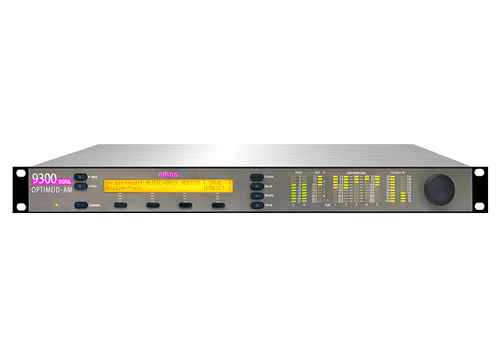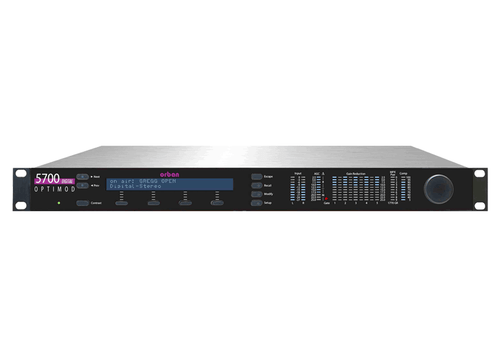Overview
OPTIMOD XPN-AM AM Broadcast Processor
Unprecedented Combination of Loudness, Cleanliness, Crispness, Speech Intelligibility and Coverage
The new OPTIMOD XPN-AM Audio Processor is based upon an AM-optimized version of Orban’s MX limiter technology that was first introduced in the Optimod-FM 8600. This revolutionary limiter technology provides an unprecedented combination of loudness, cleanliness, crispness, speech intelligibility, and coverage. Additionally, XPN-AM’s design incorporates everything Orban has learned in 42 years of AM processing experience, starting with the original Optimod-AM 9000 back in 1977.
Compared to other AM processors, the ability of Orban’s XPN-AM processor to generate greater density with lower distortion can significantly reduce power consumption with Modulation Dependent Carrier Level (MDCL) equipped transmitters. Early field tests show upwards of a 20% power savings is achievable. Depending on MDCL transmitter settings, broadcasters can maximize coverage, minimize power consumption while keeping existing coverage, or split the difference.
Features
MX Limiter
Orban’s exclusive MX Limiter increases average modulation while reducing distortion and improving speech intelligibility, and increasing HF power handling capability.
20% Power Savings
Compared to other AM processors, provides up to 20% power savings when using MDCL AMC 3 dB dynamic carrier power control.
Processing for multiple broadcast types
Suitable for long wave, medium wave, and shortwave (HF) AM broadcasts.
Processing for HD Radio
Only XPN-AM/HD version
Maximum coverage
Cuts through today’s high RF noise environments, maximizing coverage.
Diversity Delay
Mono/stereo analog AM processing and HD Radio/netcast processing with built-in diversity delay and delay ramping.
Dense positive peaks
XPN-AM can create dense positive peaks to 150% modulation.
Equalizer
Versatile transmitter equalizer can tune out tilt and ringing in transmission systems.
Variable bandwidth
Variable bandwidth from 2.5 KHz to 9.5 KHz (NRSC), with parametric input filter shapes to trade off brightness against ringing.
Complements the high frequency roll-off
Receiver equalizer shapes pre-emphasis can complement the high frequency roll-off of an “average” AM radio as determined by NRSC tests in 2006.
Specifications / Documents
Audio Processors
One instance of OPTIMOD XPN-AM software realizes a stereo AM and stereo HD/netcast audio processor (XPN-AM/HD version for HD/netcast processing required). Each processor consists of the following cascaded processing elements:
Internal Processing: Input DC Removal, Stereo Synthesizer, Mono Bass, Left/Right Phase Skew Corrector, Stereo Enhancer, Two-Band defeatable AGC with window gating, Ratings Loop-through, Equalizer/HF Enhancer, Subharmonic Synthesizer, Multiband Compressor, Peak Limiter, Automatic Loudness Controller (HD only), Transmitter Equalizer (AM only) Output.
The AM and HD processors split after the Ratings Loop through.
Frequency Response
±0.1dB, 2-20,000Hz (Bypass software running)
Input/Output Delay
Typically 450 to 1000 ms. Varies according to the number of processing features that are activated.
Input/Output Resolution
16-bit or 24-bit fixed point. If the output is configured for 16 bits, First-order noise-shaped dither can be applied prior to truncation to 16 or 24 bits from 32-bit float.
Input/Output Sample Rate
44.1, 48, 96, or 192 kHz. 48 KHz is native. 44.1, 96, and 192 kHz use high-quality synchronous sample rate converters built into OPTIMOD XPN-AM.
Internal Resolution
32-bit or 64-bit floating point, as appropriate for the processing being performed
Internal Sample Rate
48-256 kHz as needed
Noise
The output noise floor depends upon how much gain the processor is set for (Limit Drive, AGC Drive, Multiband Drive, Limiter Drive), gating level, equalization, noise reduction, etc. For analog I/O, it also depends on the performance of the I/O sound device. XPN-AM’s internal signal path is 32-bit float, with 16 or 24-bit fixed point I/O. With 24-bit digital I/O, the measured, un-weighted RMS noise at the AM digital output is better than 97 dB below 100% modulation with NRSC (9.5 KHz) bandwidth, Input Reference Level set to –20 dBFS (VU), and the AM GENERAL MEDIUM preset active.
Distortion
It is impossible to provide a simple, perceptually meaningful specification for distortion. The base distortion in the signal path is determined by the performance of the I/O sound devices, including A/D and D/A converters (if used). In Operate mode, perceptual distortion is entirely dominated by the MX peak limiter, which uses a psychoacoustic masking model to minimize distortion audibility and allows the user to trade off perceptual distortion against coverage and/or transmitter power savings.
AM Peak Control
The AM Peak limiter is oversampled at 256 kHz, yielding a worst-case overshoot with 9.5 KHz bandwidth of 0.3 dB (0.1 dB typical) at an analog or digital output and for all output sample rates.
HD Peak Control
The HD peak limiter is oversampled at 192 KHz (non-MX mode) or 256 kHz (MX mode), yielding a worst-case overshoot with 20 KHz bandwidth of 0.5 dB (0.15 dB typical) at an analog or digital output and for all output sample rates.
AM Steep-Slope Lowpass Filters
2.5 to 9.5 KHz (NRSC) in 500 Hz steps for setting transmitted AM bandwidth. The filter is distributed throughout the processing to control the output spectrum and to prevent the processing from working on frequencies that will not be transmitted. The filter’s input section has a parametric transition shape between the passband and stopband, where the frequency at the edge of the passband can be at 0.1, 3.0, or 6.0 dB down, allowing the user to trade off brightness against ringing.
HD Steep-Slope Lowpass Filter
10-19 KHz in 1 KHz steps, OFF. Can be used to provide additional anti-aliasing for low sample rate services.
Parametric Lowpass Filter
4 – 15 KHz in 1kKHz steps with selectable slopes of 6, 12, 18 or 24 dB/octave. Intended for program equalization.
Highpass Filter
20, 30, 40, 50, 60, 70, 80, 90, 100, 110, 120, 130, 140, 150, 170 or 200 Hz with selectable slopes of 6, 12, 18 or 24 dB/octave.
Equalizers
Shelving Low Bass EQ, selectable 6 dB, 12dB or 18dB/octave. Four-band Parametric EQ with analog-style bell-shaped curves. Program Adaptive HF Enhancer. Brilliance control uses Band 5 of the multiband compressor as a steep slope shelving equalizer (12 or 18 dB/octave for linear-phase or allpass crossovers respectively).
Receiver Equalizer (AM chain only)
Parametric 18 dB/octave shelf, typically +3.0 dB at 2 KHz (see Figure 3 14 on page 3-45). NRSC pre-emphasis is available.
Subharmonic Synthesizer
Frequencies from 50-90 or 60-120 Hz will produce subharmonics exactly one octave below, ensuring musicality of the effect. Subharmonic synthesis is defeated when speech is detected or when the program material already has energy in the frequency range occupied by the subharmonics.
AGC (Automatic Gain Control)
24dB gain reduction range with adjustable “Idle Gain” (typically –10 dB), Two-Band, with adjustable stereo coupling and band coupling, compression ratio control, silence gate and window gate.
Stereo Enhancer
Orban-developed L−R dynamic expansion triggered by L+R transients. To avoid artifacts and over-enhancement, it only expands L–R energy above 200 Hz.
Multiband Compressors
25dB gain reduction range, Five-Band
HD MB Crossover Frequencies
6.2 KHz, 1.6 KHz, 420 Hz, and 200/150/100 Hz (selectable)
AM MB Crossover Frequencies
3.8 kHz, 1.6 kHz, 420 Hz, and 100/150/200 Hz (selectable)
Limiter
>12dB gain reduction range (HD), >24 dB range (AM). The HD limiter provides two modes: low-IM look-ahead (to minimize CPU usage) and MX (to achieve highest performance).
Transmitter Equalizer (AM chain only)
Four presets, each with LF Gain, LF Frequency, HF Frequency, and HF Delay controls. Remote controllable via XPN-AM PC Remote application and API.
Limiter Asymmetry Control (AM chain only)
100-150% positive peaks. Included in transmitter equalizer preset.
Loudness Controller (HD chain only)
Constrains subjective loudness to a user-adjustable threshold via the 1981 Jones & Torick CBS Technology Center algorithm, as further refined and developed by Orban. The algorithm also drives a subjective loudness meter, which is displayed on the XPM-AM’s GUI. In dual-mono mode, there are two independent loudness controllers and meters. BS.1770 Safety Limiter (HD chain only): Constrains Integrated BS.1770-2 (and higher) loudness to preset value, with an attack time of 10 seconds and a release time of 3 seconds.
Number of User Presets
Essentially unlimited. User presets can be saved on the host computer’s hard drive or on other storage devices.
Audio I/O
OPTIMOD XPN-AM provides two AES3 digital inputs, two AES3 digital outputs, one stereo analog input pair, and one stereo analog output pair. It also includes a streaming audio processor that can be used as a low-delay headphone monitor or to process a stream. Basic functions such as input and output levels can be controlled from the XPN-AM Control Application.
API
IP API
Provides complete remote administration over TCP/IP. The XPN-AM Service application hosts a TCP/IP Terminal Server to allow external control of XPN-AM from either a Telnet client or a custom third party application. All XPN-AM Presets and Mixer Controls are accessible and all commands are simple text strings.
Telnet/SSH
RFC 318 compliant basic subset. Compatible with Windows Telnet and PuTTY Telnet clients.
TCP/IP Port
user assignable
Security
Multi-Level Security
In addition to normal security built into Windows, XPN-AM provides three basic password-protected security levels for its software components: Service Administrator, Processor Administrator, and Processor User.













